The gritty world of drug trafficking and quasi law enforcement is depicted in a recent CG trailer for Ubisoft’s shooter game Call of Juarez: The Cartel. yU+co created the piece, which includes Western-inspired close-contact fight sequences, shoot-outs and a final fiery vehicle crash, with the help of full body motion capture from Just Cause Productions as well as Depth Analysis’ MotionScan facial capture system. We talk to the trailer’s animation director, Richard Taylor, about bringing the Call of Juarez world to life, and to Depth Analysis about MotionScan.
Having worked with Ubisoft on previous game cinematics, Taylor looked to the game’s old-west roots in a newer contemporary setting as inspiration for the trailer’s aesthetic. “Our desert scenes are all backlit,” says Taylor, “with the sun coming from the rear so that all the characters are in shadow with sharp back edge light. That gives them a more mysterious quality and gives them scale and makes it more interesting, before we move into the darker drug world.”
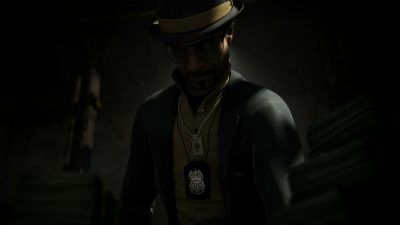 The trailer intentionally reflects the darker style of the game – an intense mix of guns, money, drugs and sex. Indeed, one of the main aesthetics of the trailer became the dust as a metaphor for cocaine. “Ubisoft came to us with the over-arching concept of dust as both a unifying visual device throughout the trailer, taking viewers from scene-to-scene, but also a symbolic one that refers to the drug trafficking that fuels the Call of Juarez: The Cartel storyline,” says Garson Yu, yU+co’s Creative Director. “It was a great idea that inspired our creative execution, and challenged us to build on it and come up with more and more clever, yet subtle, visual metaphors for dust.”
The trailer intentionally reflects the darker style of the game – an intense mix of guns, money, drugs and sex. Indeed, one of the main aesthetics of the trailer became the dust as a metaphor for cocaine. “Ubisoft came to us with the over-arching concept of dust as both a unifying visual device throughout the trailer, taking viewers from scene-to-scene, but also a symbolic one that refers to the drug trafficking that fuels the Call of Juarez: The Cartel storyline,” says Garson Yu, yU+co’s Creative Director. “It was a great idea that inspired our creative execution, and challenged us to build on it and come up with more and more clever, yet subtle, visual metaphors for dust.”
“The dust at the beginning is orangey,” notes Taylor, “but once he jumps and fires towards camera, smoke comes out of the twin-barreled shot gun and it turns to white smoke. That dust dissolves into the money and the guns on the table. Part of the idea was that the dust was going to be a major theme running through the spot and be a transitional device between sequences, but then also representing cocaine.”
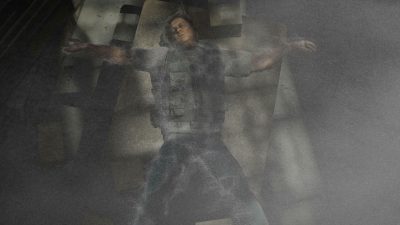 Despite that heavy adult content, Taylor had to ensure the trailer met ESRB requirements. “You never see direct hits to the face,” he notes. “They’re always hidden by a post or are from the back side. You never see a bullet enter anybody. When the girl on the balcony is shooting the bad guy, you’re seeing it from the back. Even in the last automobile crash when the bullets are going through seat, you don’t see them hit the driver, you just see the blood splattering on the windshield. That was a design constraint I had to deal with to tell the story.”
Despite that heavy adult content, Taylor had to ensure the trailer met ESRB requirements. “You never see direct hits to the face,” he notes. “They’re always hidden by a post or are from the back side. You never see a bullet enter anybody. When the girl on the balcony is shooting the bad guy, you’re seeing it from the back. Even in the last automobile crash when the bullets are going through seat, you don’t see them hit the driver, you just see the blood splattering on the windshield. That was a design constraint I had to deal with to tell the story.”
Production began as storyboards that were turned into animatics of some of the main action and complicated car crash and fight scenes. As the characters were to be motion captured, Taylor shot the performers first with a video camera to establish the choreography. Just Cause Productions then handled the full body mocap based on a video edit created by Taylor. “I think the choreography of a fight sequence has a lot to do with the angle you see it from,” he says, “in terms of where and how the punches hit and how much camera movement is going on in the shot. So it was a matter of working with the fight team and the mocap actors who are all terrific martial artists and acrobats.”
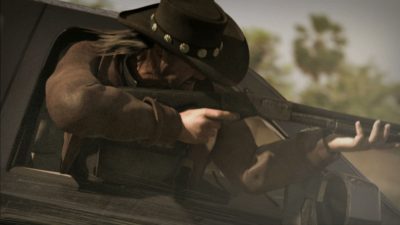 For the facial animation, Taylor and yU+co turned to Depth Analysis and their MotionScan system for detailed performance data. The system uses multiple cameras to acquire animation of the actual faces of the actors as cast. “The way it works,” explains Taylor, “is that the actors are put into real make-up, with say tattoos and everything. They sit in a white room in a chair with their head in a locked position, with more than 20 cameras around them. Then they deliver their dialogue and facial gestures.”
For the facial animation, Taylor and yU+co turned to Depth Analysis and their MotionScan system for detailed performance data. The system uses multiple cameras to acquire animation of the actual faces of the actors as cast. “The way it works,” explains Taylor, “is that the actors are put into real make-up, with say tattoos and everything. They sit in a white room in a chair with their head in a locked position, with more than 20 cameras around them. Then they deliver their dialogue and facial gestures.”
“For example,” adds Taylor, “there’s a scene at the end where Ben, the main bad guy, lights the cigarette. There was a little part of a filter in his mouth and the actor had to act in the chair like he was lighting a cigarette and covering his face with his hand, and he squints his eyes and puffs out the smoke.”
On the MotionScan set-up, Taylor utilized a teleprompter to show the actor the action of their scene to help with eyelines and directions. The data captured was then sent to Depth Analysis for processing. “What you get back is an entire head of the actor with the textures all there and the action all baked in,” says Taylor. “You can’t change the animation, but you can add hair, which we did, and clothing and hats and that type of thing.”
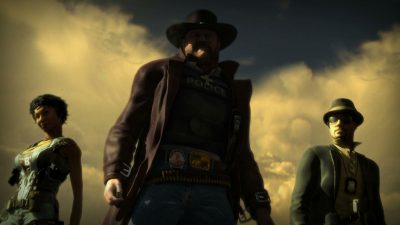 “I think it works really well,” remarks Taylor. “You’re actually seeing the actor’s real performance. If we had had to do traditional facial mocap where you have the witness points on the face and we had to model the faces, and then transfer that over, I don’t think we would have gotten nearly the performance we were after, and in the time we had, which was only about seven weeks.” yU+co then combined the facial capture, which was only down to just below the neck, with the full body mocap and applied it to CG models of the characters. Additional animation was necessary for specific shots, including for hands and props. Cloth and hair sims also made up a considerable part of the studio’s work.
“I think it works really well,” remarks Taylor. “You’re actually seeing the actor’s real performance. If we had had to do traditional facial mocap where you have the witness points on the face and we had to model the faces, and then transfer that over, I don’t think we would have gotten nearly the performance we were after, and in the time we had, which was only about seven weeks.” yU+co then combined the facial capture, which was only down to just below the neck, with the full body mocap and applied it to CG models of the characters. Additional animation was necessary for specific shots, including for hands and props. Cloth and hair sims also made up a considerable part of the studio’s work.
Additional effects in the trailer included digital environments, explosions and, of course, the dust particles. “For the explosions,” says Taylor, “we bought a package called Action Essentials, which has a lot of really great elements. The dust was mostly done in Cinema 4D and also included other particles and leaves coming close to camera or off in the distance. I really wanted them to get picked up in the gunfight and then caught in the shafts of light. All the compositing was done in After Effects.”
According to Taylor, the most difficult effect was the bullet entering the back windscreen of the van, causing the glass to fracture in a spider web-like fashion, before its driver is hit and the vehicle crashes and explodes. Ultimately the shot was a mix of keyframe animation for the car and real explosion elements. That scene, in particular, represented the unique combination of Western and contemporary worlds for the trailer.
With only a very short time to complete the trailer, the production was achieved through close collaboration between the artists at yU+Co, Ubisoft, Just Cause and Depth Analysis in order to create something both dramatic and striking. “Ubisoft really wanted a very noire piece with a limited palette of colors,” says Taylor. “But the coloration and the staging of the shots and the camera angles had to be very modern and exciting, and I think we really pulled that off.”
_______________________________________________________________
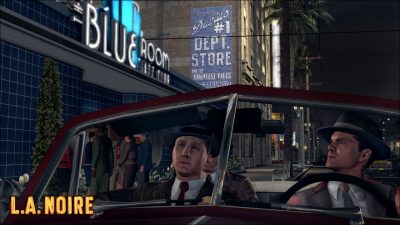
In-depth with Depth Analysis
Depth Analysis is the company behind the facial capture and animation in The Call of Juarez: The Cartel trailer. With offices in both Sydney and LA, their MotionScan system was also recently used for Rockstar Games’ L.A. Noire. Here we talk to company rep Jennie Kong about the history and tech of the company.
fxg: Can you give me a brief background of Depth Analysis?
Kong: Depth Analysis started as a research project in 2004 to investigate the possibility of camera based full body scanning. It then became a separate company in 2005 to begin research and prototyping. From there, we went from a facial scanning prototype to a production level head scanning system, with tools, processing infrastructure, production pipeline and data management tools to match. The system was relocated to LA in late 2009, and we spent 82 days capturing for L.A. Noire in 2010.
fxg: How does the MotionScan system work?
Kong: The Depth Analysis studio has 32 HD cameras set up. Each camera pair generates a 3D patch, with 16 patches overlapping forming a complete head. So, it goes from video to 3D point clouds, mesh, filtered mesh and then compressed mesh. In terms of capture, we have makeup artists and hair stylists who style and prepare the actor’s transformation using regular film makeup. The actors then enter the Depth Analysis capture room where they are seated, and we direct and shoot their performance from there.

We then record video data from the 32 HD cameras – both audio and chest joint data in one go. Selected footage is archived to tape and shipped for processing. The operators select processing settings, and the CPUs do the work, and QA the results and export to client to use. A game studio will then utilize MotionBuilder and Maya software for instance to integrate into the game.
The way MotionScan works is that it is based on stereo photogrammetry with 32 2Mpixel cameras recording in sync. Each camera pair generates a surface patch with colour and normal information, and all sixteen patches are then combined together to form a complete head. Compared to other capture systems, MotionScan doesn’t use mocap markers for facial reconstruction. We focus on representing each frame in 3D while still maintaining temporal consistency. The turnaround time is very quick and what you see is what you get – there is no need for heavy post-production animation like other systems.
From this data capture, it is then made available to the game and the character’s heads are parented to the neck of the game skeleton. The beauty of MotionScan is that once everything is captured, the performance can be lit, re-lit, positioned at any angle for easy editing – which means that the director doesn’t have to get multiple re-takes of a strong performance from every angle. It’s already there.
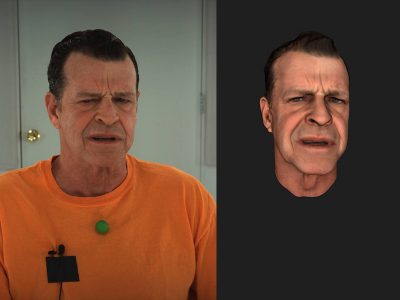
fxg: What have been some of the main challenges in capturing extreme detail in the face and hairstyles with the MotionScan system?
Kong: The main scanning assumption is Lambertian-like surfaces, which are view independent. Beards are difficult as some are not dense enough and when captured, we can see through them.
Free flowing hair can’t be captured reliably using cameras due to sampling issues and self-occlusion. The same with tears or blood, as different cameras could see different colours.
_______________________________________________________________
Call of Juarez: The Cartel Credits
Client: Ubisoft
Project: “Call of Juarez: The Cartel” trailer (:90)
Production/Design/Animation: yU+co, Hollywood, CA
Garson Yu – Creative Director
Richard Taylor – Animation Director
Andrew Honacker – CG Supervisor
Carol Wong – Executive Producer
Sarah Coatts – Producer
Ryan Wilk – Associate Producer
Jacob Medendorp – Project Coordinator / Asset Manager
Amy Hay – Rigging TD
Joe Spadaro – Rigging TD
Juan Carlos – Rigging TD
Andy Lewis – Lighter
Jeremy Lei – Lighter
Luis Cayo – Lighter
Vincent Delay – Hair/Cloth TD
Chris Christman – Hair TD
Hunter Brown – Character Animator
Gary Garza – Compositor/Designer
Stevan Del George – Compositor
Joel Ashman – Compositor
Rick Makoul – Compositor
Samuel Perez – Character Modeler / Texture Artist
Leo An – Character Modeler/Texture Artist
John Roumieh – FX TD
Karen Smith – FX TD
Jason Sikora – Editor
Mike Parks – VFX Editor
Motion Capture: Just Cause Productions
Reuben Langdon
Facial MotionScan: Depth Analysis
Oliver Bao
